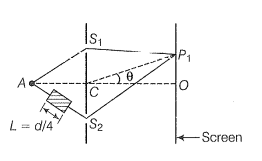A small transparent slab containing material of =1.5 is placed along AS (figure). What will be the distance from O of the principal maxima and of the first minima on either side of the principal maxima obtained in the absence of the glass slab?

Hint: The position of the maxima or minima depends on the path difference.
Step 1: Find the path difference.
ln case of transparent glass slab of refractive index, the path difference will be calculated
as
Step 2: Find the condition for maxima.
For the principal maxima, the path difference= 0
Step 2: Find the condition for minima.
For the first minima, the path difference is .
[ The diffraction occurs if the wavelength of waves is nearly equal to the slit width (d)]
On the positive side, sin
On the negative side, sin
The first principal maxima on the positive side is at distance:
The first principal minima on the negative side is at distance
D tan

© 2025 GoodEd Technologies Pvt. Ltd.